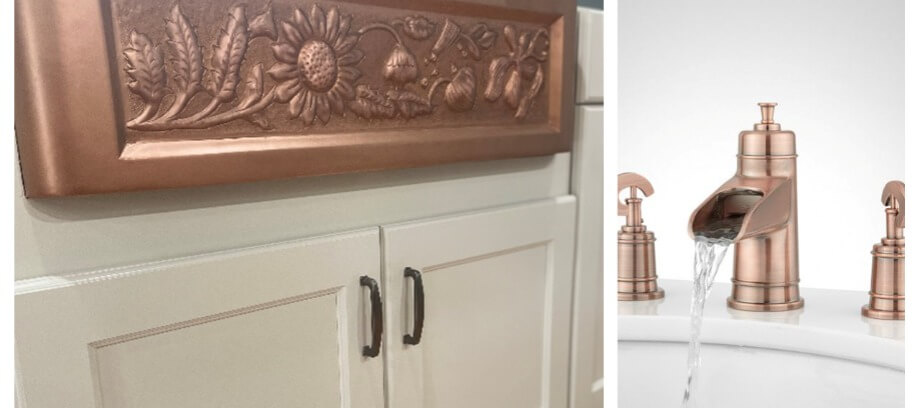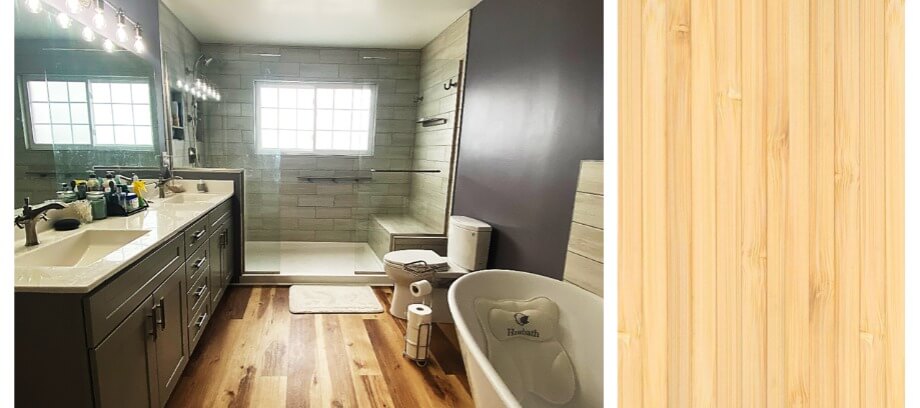
3 Materials That Keep Your Kitchen Clean For You
Ask our designers their favorite part of our process, and they’ll all say, “When it’s done, and I get to see the design in real life!” (Homeowners usually agree.) A designer’s second favorite part, however, is helping a homeowner select the materials for their design.
If you’re updating your kitchen to make it easier to clean, read here about the three types of material that help you maintain an (almost) germ-free space.

Copper: Sinks, fixtures, and cabinet hardware
How does copper help us keep our homes clean? It’s naturally antimicrobial.
Copper is a material that has been used for generations to hold water. Copper prevents the growth of bacteria and kills germs on surfaces. "EPA-registered copper kills several types of bacteria, including Staph and e-coli. It also can kill 99.9% of bacteria within 2 hours, when cleaned regularly.” (1) Not only is copper antibacterial, it’s also antiviral and anti-fungal. (2)
The way it works is this: “… Copper ions are released when microbes land on the surface. These microbes can be from dirty dishes, a sneeze, or a single touch of a finger. Essentially, these copper ions destroy the microbes’ DNA and RNA to prevent cell respiration and the spread of disease. What’s even more incredible about this is that this process prevents mutation, meaning microbes can never become resistant to copper. Instead, copper is strong enough to kill superbugs that have mutated to be antibiotic-resistant.” (2)
You can see why copper is very practical in a kitchen, because “anything that you regularly touch with your hands is also likely to get a lot of germs on it (that includes things like the taps and faucet, as well as the door and cupboard handles).” (3)
It’s rust-resistant, too, so using copper in a kitchen, or anywhere you will be using water regularly, makes sense.
It’s stylish
Copper is also trending. “2022 is the year that [copper] is going to become a more mainstream color,” predicts Homenish.com. “Copper hardware, such as handles and hinges, really stand out best against cabinets in a contrasting color.” And with dark blue as a common color for islands and base cabinets now, copper is a perfectly trending match, especially if you have “a copper sink and faucet .… Copper sinks look great in deep farmhouse styles, set against a hardwood countertop in a weathered, aged finish.” (4)
Whatever your kitchen’s style, copper fits. It can be formed into just about any size or style of cabinet pull, handle, or sink – whether your kitchen is more traditional, eclectic, modern, or rustic. It can be hammered, polished smooth and shiny, or added to other metals for a bronze look. It can tarnish over time into a brownish color, or finished into a pink hue. (5)

Antimicrobial countertops
Another surface that is constantly being touched (hence, germ-ified) is your kitchen countertop. Fortunately for homeowners, several companies have developed antimicrobial coatings and alloys over the last 10-15 years that help keep us all healthier.
Because “bacteria reproduce very quickly on a porous surface,” (6) non-porous materials are ideal for a sanitary kitchen, as it's difficult for bacteria, mold, and mildew to grow and replicate on it. (7)
Some products that meet this criterion are:
1. Quartz is one of the most durable and hygienic countertop surfaces, made from a mixture of natural minerals held together using polymers and resin. The maintenance for quartz countertops is easy too — all you need is a non-abrasive cloth and soap and water.
2. Corian®: This household-name countertop material was developed by DuPont™ over 40 years ago by blending pure acrylic resin with natural minerals. Its maintenance is a homeowner's dream because it is antimicrobial, repairable, heat-resistant, blade-resistant, and best of all, stain-resistant. All that is required for cleaning is a soft cloth and warm, soapy water.
3. Ceramic/Porcelain - Toilets specifically have been made of ceramic materials (and porcelain is one – it’s just heated to a higher temperature when it’s made) since the late 19th century. Because ceramic has an almost-zero water absorption rate, it is a non-porous material, and very easy to clean and disinfect, so it also makes a great option for countertops. “Another fundamental benefit of ceramic [or porcelain] is that mites and bacteria have no chance of nesting on its surface,” notes Atlas Concorde, a manufacturer of ceramic tile. And because these materials do not “retain moisture, the tiles prevent the proliferation of mold and fungi. Choosing porcelain … eliminates a lot of worry when it comes to hygiene.” (14)
4. Another option for countertops is stainless steel. Stainless steel is also nonporous, and it can also be wiped clean with just soap and water. It can also be scratched, though, so it's a good idea to keep cutting boards on hand. And because it does scratch, it is not a natural germ-fighter like the others on this list – but it’s easily sanitized. (8)

Antimicrobial flooring
Flooring options for kitchens are seemingly endless. Since the kitchen has the most traffic in your home, and it is where many raw materials are handled, it makes sense that to choose a material that will be antimicrobial in nature.
1. Bamboo flooring - A good option because it has antifungal agents within the material itself. Studies have shown that it also resists various bacterial strains.
2. Cork flooring - According to the NIH, "… cork displayed high antibacterial activity against Staphylococcus aureus, with a bacterial reduction of almost 100% (96.93%) after 90 minutes of incubation." Given cork's natural ability to fight the bacteria that causes staph infections, this makes it a fantastic option for fighting germs. (9)
Keep in mind that [cork and bamboo] do need to be resealed on a regular basis to keep them in good condition, so be prepared for more maintenance than other flooring. (3)
3. Luxury Vinyl Tile (LVT) is a better alternative than laminate or wood veneer, because the chemicals used to finish the surface are antimicrobial. Some LVT flooring even has the texture and other detailing to give the illusion and look of wood. (10)
4. Ceramic and porcelain tiles and slabs, as we have already noted, are resistant to 99.99% of bacteria. The aesthetics of ceramic and porcelain instantly elevate any space because they are available in a variety of finishes, including options that resemble wood, marble, and terrazzo. (11)

If you are planning a kitchen remodel and would like to discuss these or other materials with a designer, simply fill out our contact form and we will get right back to you!
List of Sources:
1. Richelieu Hardware
2. Sinkology
3. Farmhouse 40
4. Homenish.com
5. Proper Copper Design
6. Royal Stone Care
7. Pacific Quartz Surfaces
8. Kitchen Magic
9. Edesia KBS
10. Zieba Builders
11. Forbes
Bamboo flooring photo from Forbes
Let's discuss